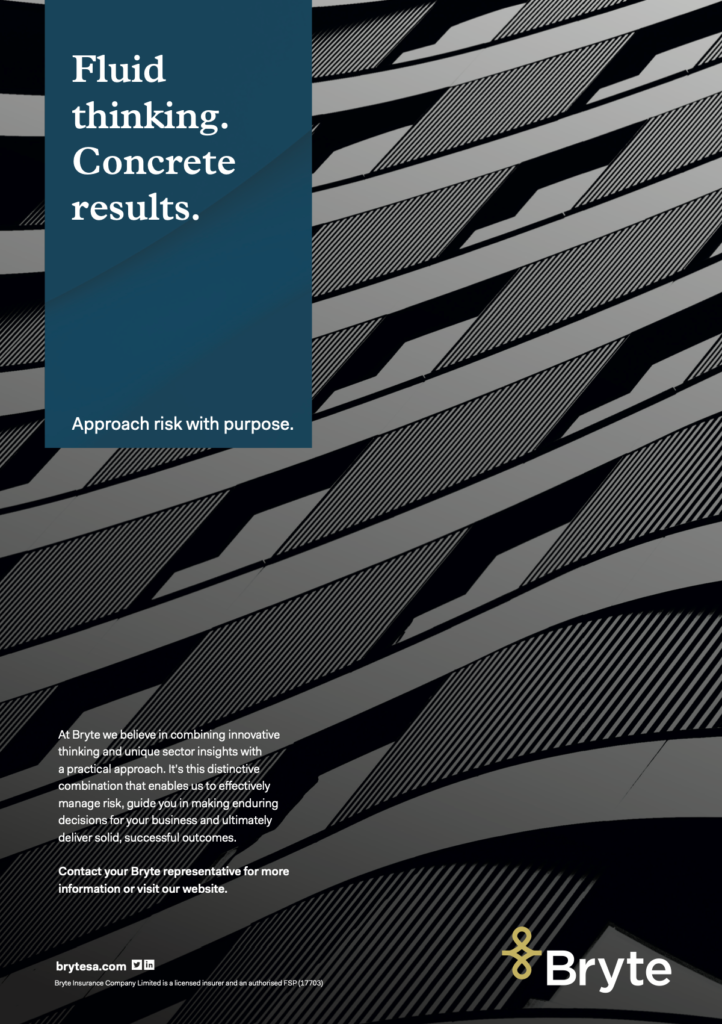
JP Holmes, National Head: Specialist Property Line of Business, Bryte
The construction sector is a key contributor to gross domestic product (GDP) and local employment, providing approximately 8% of jobs in South Africa, making it a vital industry for economic recovery. Considering South Africa’s current economic state and high unemployment rate, the impact of the revival of the construction industry has greater implications beyond the sector itself.
Multiple risks continue to burden the industry and how it operates. Since the start of the COVID-19 pandemic, supply chain interruptions have been a consistent occurrence. With several key concerns that include policy uncertainty and low economic growth, the construction sector will need more time to get back to its pre-COVID numbers, where its contribution to GDP was more than R100 billion.
The industry’s prospects for growth look promising. Several essential projects valued at R21 billion are expected to start through the government’s Infrastructure Fund. This will see contributions from the government, the private sector and development finance institutions. With the sector expecting to rebound in 2022 and possibly stabilising at an annual growth rate of 3.1% between 2023-25, more opportunities lie ahead for industry players to capitalise on meaningfully. The government’s investment in transport, energy, residential and industrial projects is also expected to play a significant role in boosting business confidence within this sector.
However, there remains general concern about the country from foreign and local investors. These stakeholders question whether it is wise to commit to projects. At the same time, South Africa continues to grapple with government corruption and electricity supply instability that remain key constraints on economic activity for every sector.
From an insurance industry perspective, intermediaries face the task of understanding the depth and diversity of risks – which continually evolve and require advisors with deep insights to assist customers effectively. Some of the new age risks vary and require different methods to deal with them:
Sustainability – The global transition to a more sustainable future, including efforts to reduce carbon emissions, is likely to have significant implications for risks related to construction. The UN’s Environmental Programme has reported that buildings and the construction industry already account for over 38% of all energy-related carbon dioxide (CO2) emissions. Direct building emissions are expected to reduce by half by 2030. This will require new materials and construction processes, resulting in an increased risk of defects, unexpected safety, environment, and health consequences.
Utilising renewables within the energy sector – Many countries have committed to transitioning to more sustainable and greener forms of power supply, which requires massive investments in new sources of renewable power, storage capacity and distribution infrastructure. Hydrogen gas has been identified as one of the key sources to move away from fossil fuels. Renewable energy is seen as a solution to power sectors such as the petrochemical and construction industries.
However, newer power sources such as hydrogen pose a risk. It is highly flammable, and leaks are quite difficult to locate before these cause disasters. The recent Medupi power plant explosion caused severe damage, affecting the power capacity of the entire country. The financial costs of the explosion also highlight the importance of having appropriate cover for such unforeseen events.
Integrating enabling technologies – The outbreak of COVID-19 alongside disruptive innovations, manufacturing machinery and equipment, has seen more reliance on digitisation, which has facilitated the emergence of new trends within the industry. This necessitates broader–scale innovation, with teams working intensely to complete projects on time while using reduced workforces in the safest possible way.
Furthermore, more modular construction is being done, which goes hand in hand with the possibility of serial loss potential and increasing risks. These include the improper usage of materials in several projects, even before the fault has been identified.
Insurers will be expected to utilise collaborations and implement proactive risk controls to ensure early catastrophic breakdowns and systems failures are identified much quicker. It is also about brokers providing support to ensure the necessary risk mitigation measures and insurance covers are in place so businesses are effectively protected should an incident occur. It is also about approaching risk holistically and pragmatically and applying bespoke solutions that drive resilience.
Regardless of sector developments and how various players approach projects and opportunities, it will depend on the effectiveness of risk mitigation and management processes for resilience and long term performance.


